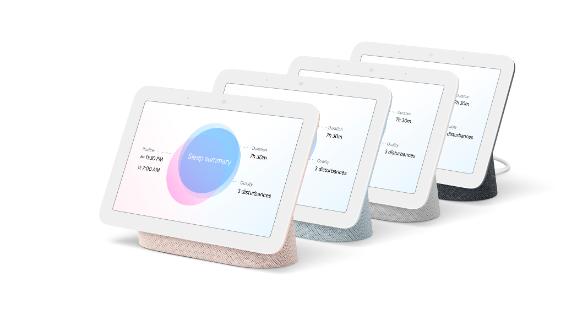
Nest Hub Second Gen: Your guide to preorders
(CNN) —
Google’s first smart display is finally getting an update after three years. The new Nest Hub, aka the second-generation, retains the classic form and doesn’t ditch the Google Assistant. It feels more refined, boasts better sound and features the Soli Sense chip inside. And unlike Amazon’s Echo Show, there’s no camera to be found.
If you’re already sold, the new Nest Hub is up for preorder now at $99.99 and will start shipping on March 30. Like the Nest Audio, the vertical pillow-like smart speaker, it comes in four colors: Chalk, Charcoal, Sand and Mist. That color wraps the base of the Nest Hub which still features a mesh cover and wraps the display on the sides. And as you may expect for a smart display, the entire experience revolves around the screen. Let’s break it out.

PHOTO: Google
The latest Nest Hub still has a very modern design and at the center is a 7-inch touch display. And it really acts as the hub for your home or rather your Google Assistant hub. You can quickly see the time, control connected smart home devices (like smart plugs), see the weather, control music playback and thousands of other things.. The biggest appeal here though is that along with audible responses from the Google Assistant, the Nest Hub also offers visuals. So when you ask for the weather —- “Hey Google, what’s the weather today?” – you’ll hear the temperature and forecast, but also see the 24 hour outlook. Handy.
When you do ask Google for some tunes, you’ll be pleased to hear there’s an improved sound experience. Nest Hub features 50% more bass than the original Hub which should deliver more booming audio. The Nest Hub still supports a variety of services like Spotify, Pandora, Apple Music and YouTube Music. The 7-inch screen is small, but it can be used to watch TV shows and movies from services like Disney+, Netflix and YouTube. You can ask for content with just your voice or use the touch screen for a hands-on approach. The Nest Hub also features a machine learning chip inside which will speed up your most used commands. This is also inside the Nest Mini and Nest Audio; it’s zippy after it learns your most common requests or commands. You’ll also find a ton of connectivity inside for getting online and connecting smart home devices —- Wi-Fi, Bluetooth and Thread top that list. All of this hardware is inside the base which sits behind the display in a woven base.
As much as we would have liked to see slimmer bezels around the display, there’s still a thick border. It’s still the norm for smart displays, but for a two-year update we would have liked to see the bezels get slim. Especially considering this is called an “edgeless” display. The bezels seem less disruptive here or a bit more flush, but we’ll need to wait and see how they actually look up close when we get the new Nest Hub in house. You can still use the Nest Hub as a photo display which is handy and the bezels here do resemble that of a photo frame.

PHOTO: Google
The top bezel contains some critical hardware for the Nest Hub and it comes in the form of the Soli Sense chip. And if you’re feeling déjà vu, the Soli chip powered face unlock and gestures on the Pixel 4, but was removed from the Pixel 5. Soli is essentially a mini radar detection chip that senses motion and doesn’t contain a lens to see a face or a body. That’s a big difference between this smart display and the bigger Nest Hub Max or Amazon’s Echo Show family.
So what does it enable here? For starters, Soli lets you use some Jedi mind tricks … like we saw on the Nest Hub Max. It detects motion and can track your hand movements. This way you can hit snooze on an alarm or control music playback with a flick of your wrist. But now Soli can also help with your wellness.
Using the Soli sensor to detect movement and the microphones to hear breathing, the Nest Hub will feature Sleep Sensing. This is a new core part of the smart display that is launching in a preview stage to track your sleep, monitor for disturbances and analyze the space of the room. All of this data comes together and after a few days, the Nest hub will make recommendations for you on how to sleep better. And like most features, you can either use Sleep Sensing or just not use it.
While we haven’t been able to test the Nest Hub yet, we are quite intrigued. You’ll place the Nest Hub on your nightstand and it will face you while you’re sleeping. The Soli sensor, using radar and motion detection, will track general movements or work with the microphones to monitor breathing. If you’re tossing and turning, it will notice. Same for coughing or snoring. It will also take a look at the brightness of the room and the temperature to factor in how it might be affecting your sleep. And if you share a bed, the Nest Hub knows to detect the closest person. If you want to track both people in the bed, you can put a Nest Hub on each nightstand.

PHOTO: Google
Sleep Sensing is still in beta, so we don’t expect it to be perfect and Google isn’t saying what it will look like in the future. The tech giant does own Fitbit, so we could see it becoming a part of Fitbit Premium, staying free or becoming a tiered system with a subscription required for some features.
We’re eager to try it, especially since there will be deep integration with Google Fit. This means you can view your sleep data on the Nest Hub or on the go in the mobile app. The team at Nest has partnered with the American Academy of Sleep Medicine for guidance and has been testing Sleep Sense for several months with over 10,000 nights of sleep monitored.
Yes, the new Nest Hub looks familiar —- but at $99.99 it’s delivering more value with faster access to the Google Assistant, a cleaner design, better sound and the Soli sense for some added fun. The latter enables hand gestures, something we appreciated on the Nest Hub Max, and a Sleep Sensing feature which takes a personal but not creepy approach to helping you improve your sleep.
You can preorder the Nest Hub now for $99.99 from Best Buy and Walmart. It’s available in Chalk, Charcoal, Sand and Mist.

















